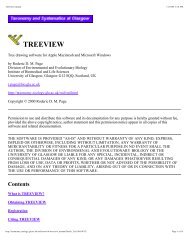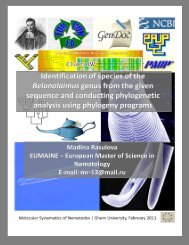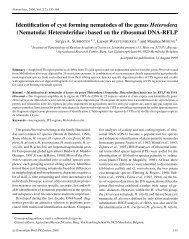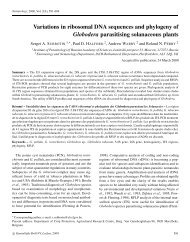Description of Tylenchulus musicola sp. n. (Nematoda ...
Description of Tylenchulus musicola sp. n. (Nematoda ...
Description of Tylenchulus musicola sp. n. (Nematoda ...
You also want an ePaper? Increase the reach of your titles
YUMPU automatically turns print PDFs into web optimized ePapers that Google loves.
Z. Tanha Maafi et al.<br />
Table 2. Primer sets used in the present study.<br />
Primer code Sequence 5 ′ → 3 ′ Amplified gene Amplicon length (bp) References<br />
TW81 GTTTCCGTAGGTGAACCTGC ITS-rRNA 809-841 Tanha Maafi<br />
AB28 ATATGCTTAAGTTCAGCGGGT et al. (2003)<br />
D2A ACAAGTACCGTGAGGGAAAGTTG D2-D3 <strong>of</strong> 28S rRNA 774-777 Subbotin et al.<br />
D3B TCGGAAGGAACCAGCTACTA (2006)<br />
D2A ACAAGTACCGTGAGGGAAAGTTG D2-D3 <strong>of</strong> 28S rRNA 361-364 This study<br />
<strong>Tylenchulus</strong> <strong>sp</strong>ecific TAGGYAAAGCKTGCTRTTRCCA<br />
TW81 GTTTCCGTAGGTGAACCTGC ITS-rRNA 113 This study<br />
Semipenetrans <strong>sp</strong>ecific GGACTCTGCTCAACCTGGTAGA<br />
TW81 GTTTCCGTAGGTGAACCTGC ITS-rRNA 190 This study<br />
Musicola <strong>sp</strong>ecific CGCAGACTCGCCAGTCGTAG<br />
TW81 GTTTCCGTAGGTGAACCTGC ITS-rRNA 690 This study<br />
Furcus <strong>sp</strong>ecific ACCAGACGCACAAAGTACAGAC<br />
TW81 GTTTCCGTAGGTGAACCTGC ITS-rRNA 767 This study<br />
Graminis <strong>sp</strong>ecific GCTATTGCGAGTCTCCTAGGG<br />
TW81 GTTTCCGTAGGTGAACCTGC ITS-rRNA 344 This study<br />
Palustris <strong>sp</strong>ecific AGGCTGTCGTAACGCTTCGCA<br />
Ts-SF TACCAGGTTGAGCAGAGTTCTT ITS-rRNA 293 Liu et al.<br />
Ts-SR TCCTACCCTTCCACAGCG (2011)<br />
Kit (Qiagen, Valencia, CA, USA) according to the manufacturer’s<br />
instruction and cloned as described by Tanha<br />
Maafi et al. (2003). PCR products <strong>of</strong> one or more clones<br />
from each sample were sequenced in the Genomic Center,<br />
University <strong>of</strong> California, Riverside, CA, USA. The newly<br />
obtained sequences have been submitted to the GenBank<br />
database under accession numbers JN112247-JN112288<br />
as indicated in Table 1.<br />
RFLP-ITS-RRNA<br />
Threet<strong>of</strong>iveμl <strong>of</strong> purified PCR product was digested<br />
by one <strong>of</strong> the following restriction enzymes: AvaI, BseNI,<br />
BsuRI or Hin6I in the buffer stipulated by the manufacturer.<br />
The digested DNA was run on a 1.4% TAE buffered<br />
agarose gel, stained with ethidium bromide, visualised<br />
on UV transilluminator and photographed. The length <strong>of</strong><br />
each restriction fragment from the PCR products was obtained<br />
by a virtual digestion <strong>of</strong> the sequences using Web-<br />
Cutter 2.0 (www.firstmarket.com/cutter/cut2.html) or estimated<br />
from a gel.<br />
PCR WITH GENUS AND SPECIES-SPECIFIC PRIMERS<br />
Genus-<strong>sp</strong>ecific and <strong>sp</strong>ecies <strong>sp</strong>ecific primers were designed<br />
using sequence alignment <strong>of</strong> D2-D3 <strong>of</strong> 28S rRNA<br />
and ITS-rRNA gene, re<strong>sp</strong>ectively (Table 2). All <strong>Tylenchulus</strong><br />
and Trophotylenchulus floridensis samples were used<br />
to test the <strong>sp</strong>ecificity <strong>of</strong> PCR with genus-<strong>sp</strong>ecific and<br />
newly designed <strong>sp</strong>ecies-<strong>sp</strong>ecific primers. The PCR mixture<br />
was prepared as described by Tanha Maafi et al.<br />
(2003). PCR for detection <strong>of</strong> all <strong>sp</strong>ecies <strong>of</strong> the genus<br />
was run with a <strong>Tylenchulus</strong>-<strong>sp</strong>ecific primer and the D2A<br />
primer. PCR for <strong>sp</strong>ecies-<strong>sp</strong>ecific detections were run in<br />
a multiplex condition with all five <strong>sp</strong>ecific primers and<br />
the TW81 primer in a tube and also separately with each<br />
<strong>sp</strong>ecies-<strong>sp</strong>ecific primer set in a tube. The newly designed<br />
<strong>sp</strong>ecies-<strong>sp</strong>ecific primer for T. semipenetrans were compared<br />
with primer set proposed by Liu et al. (2011) (Table<br />
2) using different numbers <strong>of</strong> J2 in samples. The PCR<br />
amplification pr<strong>of</strong>ile consisted <strong>of</strong> 4 min at 94°C; 30 cycles<br />
<strong>of</strong> 1 min at 94°C, 45 s at 57°C and 45 s at 72°C, followed<br />
by a final step <strong>of</strong> 10 min at 72°C. Two μl <strong>of</strong> the PCR products<br />
were run on a 1.4% TAE buffered agarose gel, stained<br />
and photographed.<br />
SEQUENCE AND PHYLOGENETIC ANALYSIS<br />
The newly obtained sequences for each gene were<br />
aligned using ClustalX 1.83 (Thompson et al., 1997) with<br />
default parameters with their corre<strong>sp</strong>onding published<br />
gene sequences, ITS-rRNA or D2-3 <strong>of</strong> 28S rRNA, re-<br />
356 Nematology
















